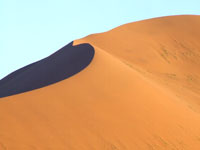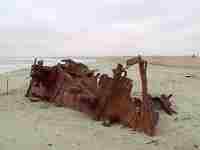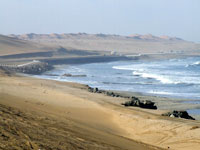The Namib Desert Travel Guide
The Namib Desert is the oldest and most arid desert region in the world, having been around for more than 80 million years. In the Nama language, 'Namib' means 'vast', and this description perfectly suits the miles of barren landscape stretching endlessly along Namibia's Atlantic coastline.
In the north, the Skeleton Coast lies as an intensely mysterious, inhospitable area of treacherous rocks, sandbanks, dry gravel plains, and isolated, flat-topped mountains. The bleak wilderness is especially eerie when blanketed in thick coastal fog, brought about by the collision of the cold sea air and searing heat of the harsh interior.
Over the centuries, shipwrecked sailors soon joined the whale and seal skeletons that littered the coast, having no chance of survival in the wastes of the Namib Desert. Its appeal lies in its untouched quality, the colours and changing moods of the large landscape, and the flora and fauna's incredible adaptions to desert life.
The southern Namib forms part of the Namib-Naukluft Park, one of Africa's most interesting and diverse nature reserves. It includes Sandwich Lagoon, an important wetland area for migratory birds, as well as canyons, rivers, and the Naukluft mountain massif. It is home to many animal species, particularly the Hartmann's mountain zebra. This section of the Namib Desert is characterised by an endless sea of orange sand dunes, and the famous Sossusvlei dunes, which are among the highest in the world.
Situated along the coast, the charming little seaside resort of Swakopmund emerges from the desert stretch. Its distinctly German character and old world charm make it a great base for any holiday in the Namib Desert.
Things to do in The Namib Desert
The Namib Desert boasts the dauntingly desolate landscape of the Skeleton Coast, some of the biggest sand dunes in the world, uniquely adapted desert wildlife, and a number of breathtaking natural attractions.
Highlights of the Skeleton Coast National Park include the Agate Mountain saltpans, the clay castles of Hoarusib, and the Cape fur seal colony at Cape Fria. The clay pans and huge orange sand dunes of Sossusvlei are among the most famous tourist attractions in Namibia.
One of the best places to stay when exploring the desert is the charming seaside resort of Swakopmund, located close to a number of superb desert landscapes. It has wonderful food, great beaches, and many water sports and extreme sports facilities.
Walvis Bay is a good base for travel in the Namib, particularly for birdwatchers. Many tour operators offer a variety of desert wildlife safaris, boat tours along the coast, and 4x4 jaunts through surreal terrain. Surfers should head to Skeleton Bay, and there will be no disappointment for those interested in dune boarding and scuba diving in Namibia.

Sossusvlei
The clay pans of Sossusvlei in the Namib Desert are one of the must-see attractions in Namibia. The dunes are among the highest in the world, reaching more than 960 feet (300m), and are a wondrous sight of endless rolling shapes and sharp crests sculpted by the wind. The beautiful black and white Oryx antelope is occasionally spotted in the meagre shade of the thorn trees, lizards leave their tiny trails on the pristine mounds of sand, and the black 'tok tokkie' beetle is commonly seen stumbling over the red clay surface. The area is also home to ostriches and springbok. The dunes are located roughly 37 miles (60km) from the Sesriem Gate, which is the entrance to the park.

Skeleton Coast National Park
The Skeleton Coast National Park is infamous for inaccessible shores and rough waters. The local San used to call it 'The Land God Made in Anger', while Portuguese sailors named it 'The Gates of Hell'. It's a barren yet hauntingly beautiful destination for photographers, its natural formations creating a surreal world. The Skeleton Coast National Park has some interesting attractions, including the Agate Mountain saltpans, the clay castles of the Hoarasib, and the large Cape fur seal colony at Cape Fria. Known as a great surfing destination and for having a stunning night sky, the heavens are undimmed by human settlements.

Swakopmund
Swakopmund is an enchanting little seaside town in the middle of the Namib Desert, which has many colonial buildings and a distinctly German character. The region's food specialities include rock lobster, fish, and Swakopmund oysters. Swakopmund is known as a paradise for extreme sports, and popular activities include sand boarding, paragliding, dune carting, hot-air ballooning, shark fishing, and quad biking. The stretch of coast is also famous for its beach angling. Visitors who aren't looking for death-defying activities will enjoy attractions in Swakopmund such as the Cape Cross Seal Colony, the National Marine Aquarium, and the Rossmund Desert Golf Course, which is one of very few all-grass desert golf courses in the world.
Namibia travel info
Electricity
Electrical current is 220 volts, 50Hz. Round three-pin plugs are standard.
Language
English is the official language, but many people also speak Afrikaans and German. There are also several indigenous languages spoken, mainly in the rural areas.
Money
The official currency is the Namibian Dollar (NAD), which is divided into 100 cents. Its value is equal to the South African Rand, which is accepted as legal currency in Namibia. Major credit cards are accepted, while foreign currency can be exchanged at any bank or bureau de change. ATMs may not be available in remote areas.
Tipping
Tips of 10 percent are expected where a service charge has not been included in the bill. Tour guides, game rangers, and trackers rely on tips for their income and should be tipped accordingly.
Health
Typhoid, hepatitis A, and hepatitis B vaccinations are recommended for travel to Namibia. Safety regulations in Namibia require all visitors who are over the age of nine months to have a yellow fever certificate if they're arriving from a country with a risk of transmission. There is a malaria risk in the northern region of Namibia during the rainy season (January to April).
There has been an increase in the cases of rabies among dogs in Windhoek, so travellers at risk of animal bites should consider a rabies vaccination; everyone five years of age and older should get fully vaccinated for COVID-19 before visiitng. HIV/AIDS is prevalent and precautions are essential, although travellers are seldom at risk unless engaging in unprotected sex. Cholera outbreaks do occur, so visitors should drink only boiled or bottled water, avoiding ice in drinks.
There are good medical facilities in Windhoek, but medical insurance is essential as treatment is expensive. Outside of the main cities, medical treatment may be hard to come by. Travellers to Namibia should seek medical advice at least four weeks prior to departure. For peace of mind, it is best to take prescription medications along when travelling. Medicines should be kept in their original packaging and accompanied by a signed and dated letter from a doctor, detailing why the medication is needed.
Safety
The majority of visits to Namibia are safe and trouble free, but muggers in Windhoek sometimes target foreign tourists. Theft from vehicles does occur, especially at service stations, so valuables should be kept out of sight and cars should be locked. Travellers should avoid using taxis if possible and should never take one alone. It's best to be especially careful when travelling in the Caprivi Strip; drivers should use it during daylight hours only, both for general safety and to avoid livestock, which wander onto roads causing accidents. The terrorism threat in Namibia is very low, with no major incidents of violence against foreigners reported.
Local customs
It is best to check before taking pictures of State House or properties where the President is residing, as well as any buildings guarded by the army or police. Some sexual relations between men are criminalised in Namibia, although these laws may not always be enforced.
Doing business
Business in Namibia is somewhat formal, although drinking and socialising are an important part of building good working relationships. Standard business etiquette applies. Dress tends to be formal, though lightweight materials tend to be worn in the hotter seasons, and punctuality is important. People shake hands on greeting and leaving, and are generally polite and professional. English is the language of business, though German and Afrikaans are widely spoken. Business hours are usually 9am to 5pm, Monday to Friday.
Duty free
Travellers to Namibia over 16 years do not have to pay duty on 400 cigarettes, 50 cigars and 250g of tobacco; 2 litres wine and 1 litre spirits or liquor; 50ml perfume and 250ml of eau de toilette; and gifts to the value of NAD 1,250.
Communications
The international access code for Namibia is +264. The outgoing code is 00 followed by the relevant country code (e.g. 0027 for South Africa). Large parts of the country are not covered by the mobile network, so a satellite phone is a good backup option for those heading off the beaten track. WiFi is increasingly available in hostels, hotels, lodges and guesthouses; travellers can purchase local prepaid SIM cards for unlocked phones.
Passport & Visa
All foreign passengers to Namibia must have confirmed return or onward tickets, and the necessary travel documentation for their next destination. Additionally, visitors should ensure that they have at least two blank pages remaining in their passports for entry and departure endorsements from the Namibian Immigration Service. A yellow fever vaccination certificate is required to enter Namibia if visitors are arriving from or have transited through an infected area. All travellers must have a passport that is valid for at least six months beyond the period of intended stay in Namibia.
Entry requirements
US citizens must have a passport that is valid for at least six months beyond their planned date of departure, and at least three completely blank pages are required for entry. No visa is required for tourist or business-related stays of up to three months.
British passports should be valid for a minimum period of six months from the date of entry into Namibia and have at least one completely blank page for Namibian immigration to use. If British travellers are also visiting South Africa, they should be aware that although South African authorities state they require one blank passport page for entry, some officials insist on two blank pages. If travellers plan to take this route, they should make sure they have a total of three blank pages. No visa is required for tourist or business-related stays of up to three months.
Canadian passports must be valid for a minimum of six months after the date of entry to Namibia, but no visa is required for tourist or business-related stays of up to three months.
Australian passports must be valid for a minimum of six months after the date of entry to Namibia, but no visa is required for tourist or business-related stays of up to three months.
South African passports must be valid for a minimum of six months after the date of entry to Namibia, but no visa is required for tourist or business-related stays of up to three months.
Irish passports must be valid for a minimum of six months after the date of entry to Namibia, but no visa is required for tourist or business-related stays of up to three months.
New Zealand passports must be valid for a minimum of six months after the date of entry to Namibia, but no visa is required for tourist or business-related stays of up to three months.
Useful contacts
Namibian Tourist Office, Windhoek: +264 (0)61 290 6000 or info@namibiatourism.com.na or www.namibiatourism.com.na
112 (fire and rescue, police, medical emergencies)Embassies / consulates in other countries
Embassy of Namibia, Washington DC, United States (also responsible for Canada): +1 202 986 0540.
Namibia High Commission, London, United Kingdom (also responsible for Ireland): +44 (0)20 7636 6244.
Namibia High Commission, Pretoria, South Africa: +27 (0)12 481 9100.
Embassies / consulates in Namibia
United States Embassy, Windhoek: +264 (0)61 295 8500.
British High Commission, Windhoek: +264 (0)61 274 800.
Canadian Consulate, Windhoek: +264 (0)61 251 254.
Australian High Commission, Pretoria, South Africa (also responsible for Namibia): +27 (0)12 423 6000.
South African High Commission, Windhoek: +264 (0)61 205 7111.
Irish Embassy, Lusaka, Zambia (also responsible for Namibia): +260 211 291 298.
New Zealand High Commission, Pretoria, South Africa (also responsible for Namibia): +27 (0)12 435 9000.



